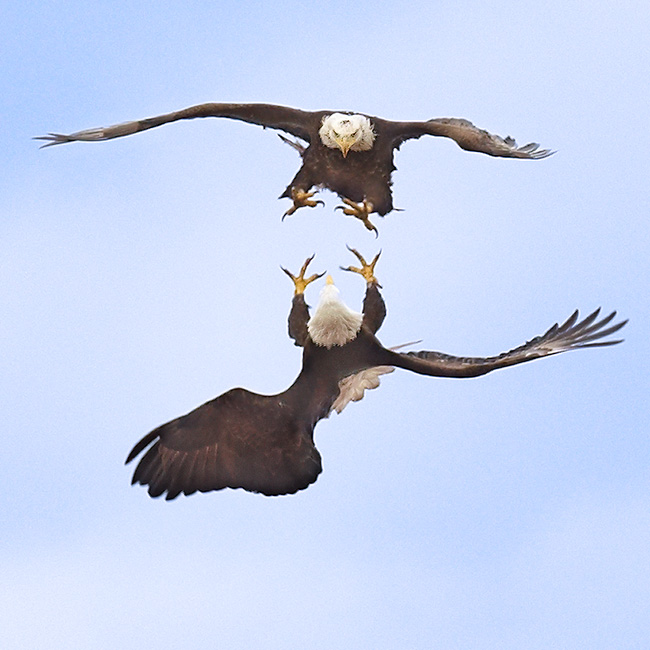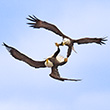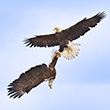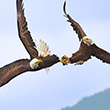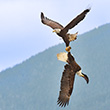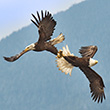
Availability: Undetermined - Enquiries?
In the Field
Courtship & Cartwheels #2. Prince Rupert, BC, Canada. June 1, 2008.
This is the second shot in a sequence of images of Bald Eagles performing a courtship display called a "Cartwheel Display". For more information about both the display and the shooting conditions, see the information under the "In the Field" tab of the first shot - Courtship & Cartwheels #1.
In this image the two eagles the birds have just locked talons and begun the first spin in the sequence...
Behind the Camera
Courtship & Cartwheels #2. Prince Rupert, BC, Canada. June 1, 2008.
Digital Capture; Compressed RAW (NEF) 14-bit format; ISO 900.
Nikon D3 with Nikon 200 mm f/2G ED-IF AF-S VR lens paired with a 1.4x TC-14EII teleconverter (280 mm equivalent) - handheld. VR turned to "On" and in "Normal" mode.
1/1000s @ f7.1; +1.0 stop compensation from matrix-metered exposure setting.
At the Computer
Courtship & Cartwheels #2. Prince Rupert, BC, Canada. June 1, 2008.
RAW Conversion to 16-bit TIFF, including first-pass (capture) sharpening, exposure compensation and slight shadow/highlight adjustment using Phase One's Capture One. Multiple RAW conversions (2 at different exposure settings) to extend dynamic range of captured image, in this case primarily to restore shadow detail on the shaded surfaces of the eagles' wings.
All further digital correction on 16-bit TIFF file using Adobe's Photoshop CS3, including compositing and masking of two exposure versions, selective application to both warming and cooling filters, selective saturation enhancement, and selective sharpening for web output.
Conservation
Courtship & Cartwheels #2. Prince Rupert, BC, Canada. June 1, 2008.
Ten percent of the revenue generated by this image will be donated to Raincoast.
Species Status in Canada*: This species is not designated as at risk. The Bald Eagle was listed as "Endangered" in the contiguous US states from 1967 to 1995. In 1995 it was downlisted to "Threatened". On June 28, 2007 Bald Eagles were removed from the list of endangered and threatened species - a true American conservation success story.
The Bald Eagle (Haliaeetus leucocephalus) is a very large bird of prey with broad wings. Adults possess characteristic white ("bald") heads. It takes Bald Eagles a full five years to attain their characteristic adult plumage (including their nearly pure white head and tail). In the years prior to the development of their adult plumage they are easy to confuse with Golden Eagles. Being very broad-winged Bald Eagles are able to use an energy-efficient flapping-soaring style of flight. While many people like to think of the Bald Eagle as a fierce hunter, in reality they hunt only as a last resort. More commonly they scavenge for their prey. Additionally, they often klepto-parasitize other weaker species such as Osprey, commonly stealing the other species hard-earned prey items. The Bald Eagle is, of course, the national emblem of the United States (Benjamin Franklin argued against this - his preference was for the Wild Turkey).
These Bald Eagles were photographed in Prince Rupert, BC in the heart of the Great Bear Rainforest. While Bald Eagles are currently not under the threat of extinction, they do, of course, require suitable breeding habitat to continue to thrive. The Raincoast Conservation Society (and Foundation) is an effective and efficient organization that has been fighting for protection of this unique habitat. If you are looking for a meaningful way to contribute to the conservation of this amazing ecosystem, Raincoast will provide maximal "bang" for your conservation dollars.
*as determined by COSEWIC: The Committee on the Status of Endangered Wildlife in Canada



















